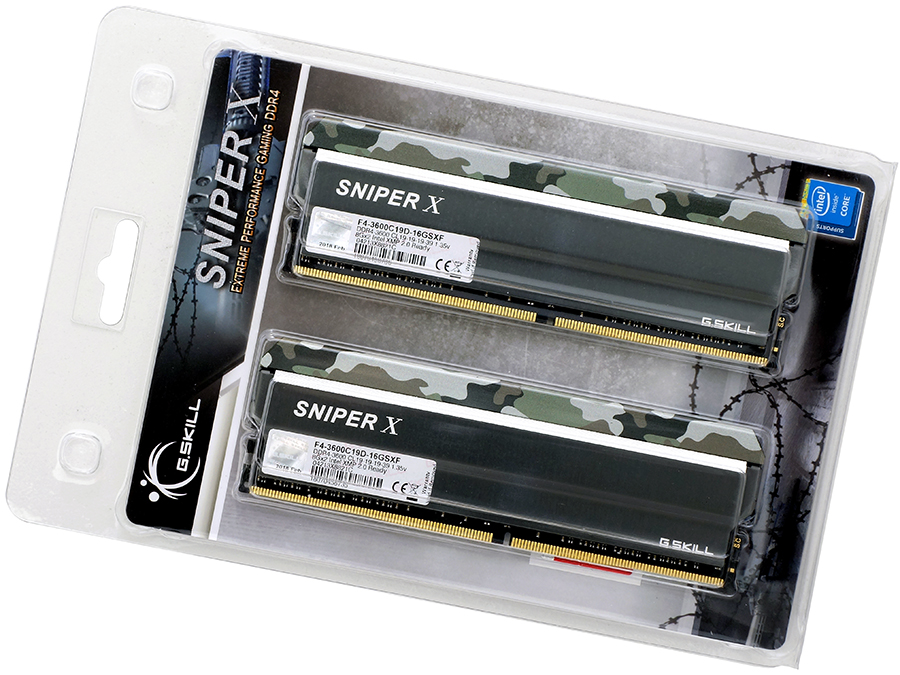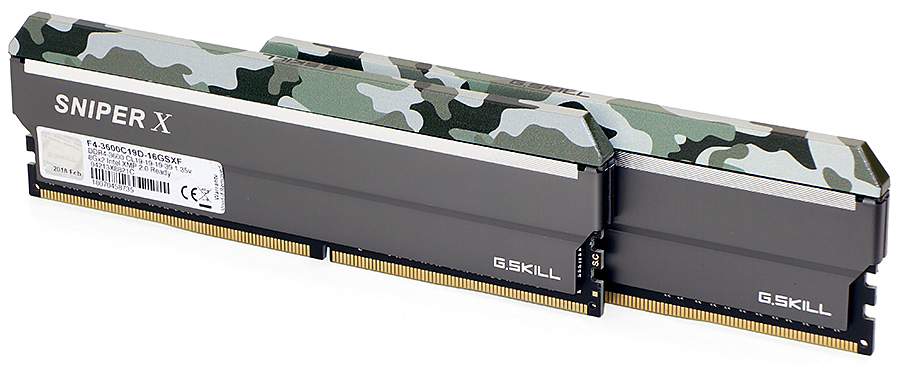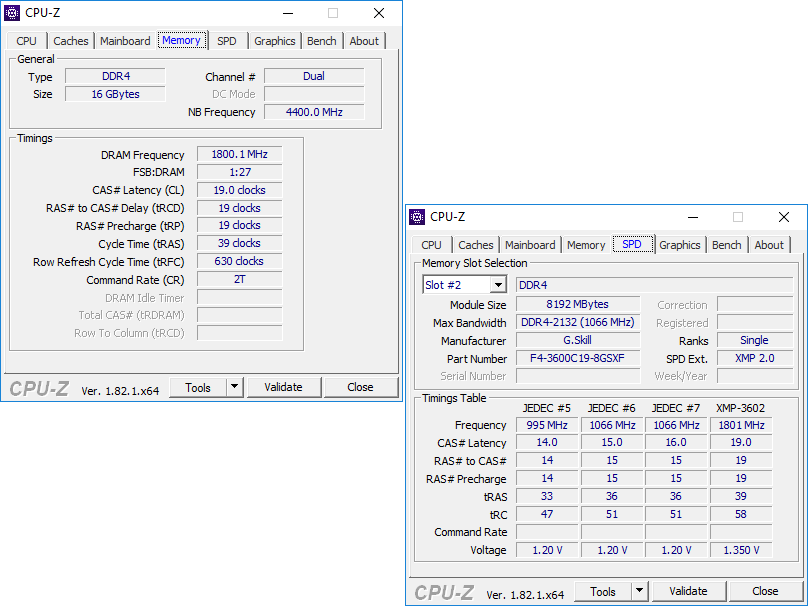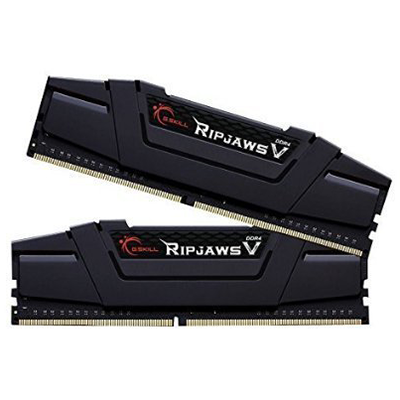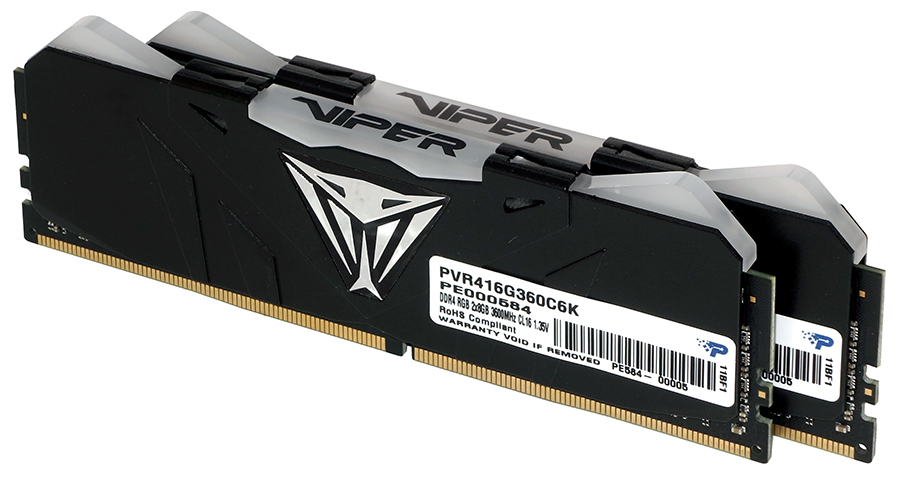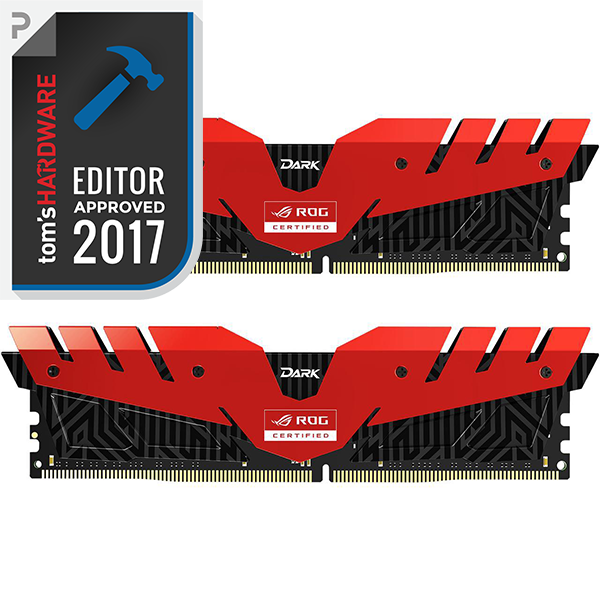Early Verdict
G.Skill’s Sniper X DDR4-3600 is well priced to attract value-seeking performance PC builders.
Pros
- +
Good performance
- +
Aggressive pricing
- +
Comparatively better overclocking
Cons
- -
Performs similarly to the firm’s own DDR4-3200
Why you can trust Tom's Hardware
Features & Specifications
G.Skill’s game-themed memory line, Sniper X, is available in classic camo, urban camo and, just in case you’re trapped behind enemy lines in a simulation with nothing but a pair of heat spreaders for concealment, digital camo. Understanding that people with windowed cases often divert to showmanship before and after a tournament, G.Skill put the real tech underneath those pretty covers.
We’re looking at two 8GB DDR4-3600 modules designed with eight 8Gb ICs rated at CAS 19. Understanding that cycle time is the inverse of frequency, that latency falls just outside of our “performance standard,” which is 1 cycle of latency per 200MHz of data rate, or CAS 18 for DDR4-3600. G.Skill knows that, too, and it has priced this kit to attract value-seeking performance enthusiasts.
Booting at DDR4-2133 CAS15 prior to the enabling of XMP mode, motherboards use its XMP values to automatically reset to DDR4-3600 at 19-19-19-39 primary timings and 1.35V.
G.Skill DRAM carries a lifetime replacement limited warranty.
Comparison Products
Memory IC availability is constantly changing, and we’re anxious to put the old DIMMs behind us, yet one kit remains interesting if only because it keeps beating all the newer stuff: T-Force Dark ROG modules used twice as many ICs at half the density to fill both sides with a full rank. That’s strikingly like having two modules on a single slot, and it allows two DIMMS to satisfy the Intel memory controller’s preference for four total ranks.
Once the old ICs are gone, dual-rank DIMMs will only be available at 16GB each (i.e., you’ll need to buy 32GB to get four total ranks). We look forward to testing more 32GB kits, for those who can afford them…
We’ve expanded outward from our Corsair DDR4-4600 review by switching to a board that supports four DIMMs. MSI’s Z370 Godlike Gaming doesn’t have any memory-overclocking advantages of the smaller board used in that review, but it has similar performance scaling and can push several of our kits past DDR4-4000. We’re also retaining the hardware from its review, including its GeForce GTX 1080 card and Toshiba/OCZ NVMe SSD.
Get Tom's Hardware's best news and in-depth reviews, straight to your inbox.
MORE: Best Memory
MORE: DDR DRAM FAQs And Troubleshooting Guide
MORE: All Memory Content
-
marcelo_vidal I get a dual 1366 board new for 100 dollar and 1 dollar for two quad core cpus and with 60 dollar i will get 48gb ddr3 ecc. Why spend 200 dollar in 16gb of ram ?Reply -
Gam3r01 Reply20869135 said:I get a dual 1366 board new for 100 dollar and 1 dollar for two quad core cpus and with 60 dollar i will get 48gb ddr3 ecc. Why spend 200 dollar in 16gb of ram ?
Because you are comparing outdated server hardware to high end modern RAM?
There is literally no comparison here. -
Crashman Reply
There's always a strain of responses from people who either didn't notice the memory price inflation of 2017, or want us to assign the blame for that inflation to whatever model we're reviewing.20869418 said:20869135 said:I get a dual 1366 board new for 100 dollar and 1 dollar for two quad core cpus and with 60 dollar i will get 48gb ddr3 ecc. Why spend 200 dollar in 16gb of ram ?
Because you are comparing outdated server hardware to high end modern RAM?
There is literally no comparison here.
-
gaborbarla I would love to see a more comprehensive version of this article. Something like a couple of Corsair Vengeances thrown in there as well as basic value RAM that most people buy.Reply
I have done quite a bit of research on whether it is worth it to worry about RAM for gaming, and the answer is turned out to be a definite yes. The reason however is not a massive increase in max FPS. Only very few games like F1 2015 make a difference with faster RAM in these tests. But most games will make a difference in MIN FPS. At the time when there are explosions and other hectic things going on, often faster RAM will reduce the stutter by up to 30%. Many people know what I am talking about. Those pesky slowdowns is what I want to get rid of, and fast RAM does actually help with that apparently. It seems that one can definitely not go simply on MHz of the RAM. Thanks for the informative article. After seeing this article the Viper really caught my eye. It should be quite good at reducing MIN FPS stutter. -
Crashman Reply
Since latency is the inverse of frequency, DDR4-3600 CAS 18, DDR4-3200 CAS 16, DDR4-2800 CAS 14, and DDR4-2400 CAS 12 all have the same real-time latency. When you're talking about latency-specific applications, it's best to keep in mind that your best performance will happen with the lowest real-time latency. If we use "Double the latency cycles and add two zeros" for the baseline data rate at any given latency group, this specific kit is slightly slower than the 3600-18 baseline at 3600-19, and gets no performance-specific recommendation. It's price competitively though.20869634 said:I would love to see a more comprehensive version of this article. Something like a couple of Corsair Vengeances thrown in there as well as basic value RAM that most people buy.
I have done quite a bit of research on whether it is worth it to worry about RAM for gaming, and the answer is turned out to be a definite yes. The reason however is not a massive increase in max FPS. Only very few games like F1 2015 make a difference with faster RAM in these tests. But most games will make a difference in MIN FPS. At the time when there are explosions and other hectic things going on, often faster RAM will reduce the stutter by up to 30%. Many people know what I am talking about. Those pesky slowdowns is what I want to get rid of, and fast RAM does actually help with that apparently. It seems that one can definitely not go simply on MHz of the RAM. Thanks for the informative article. After seeing this article the Viper really caught my eye. It should be quite good at reducing MIN FPS stutter.
Most people still need a calculator to determine that DDR4-3600 CAS 16 is going to be quicker than DDR4-2800 CAS 13. And while people with a good mind for proportion will automatically understand that 3600 CAS 19 is going to be quicker than 2800-15 (because the one extra cycle is a smaller portion of the total latency cycles), we have to keep in mind that not everyone has that mindset. Using "double-the-latency then add-two-zeros" as a baseline is a good method for people who don't want to bother with the calculator. Using that method for CAS 19, you'd expect DDR4-3800, and since it's DDR4-3600, you can think "it's slower than the performance-DRAM baseline".
